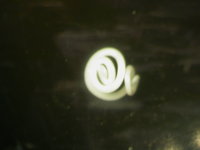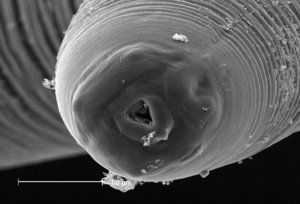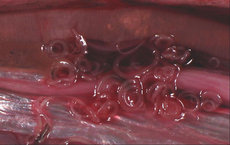Definition
Roundworm infections are diseases of the digestive tract and other organ systems caused by nematodes. Nematodes are parasitic worms with long, cylindrical bodies.
Description
Roundworm infections are widespread throughout the world, with some regional differences. Ascariasis and trichuriasis are more common in warm, moist climates where people use human or animal feces for fertilizer. Anisakiasis is most common in countries where raw or pickled fish or squid is a popular food item.
Causes & symptoms
The causes and symptoms of roundworm infection vary according to the species. Humans acquire most types of roundworm infection from contaminated food or by touching the mouth with unwashed hands.
Anisakiasis
Anisakiasis is caused by anisakid roundworms. Humans are not the primary host for these parasites. Anisakid roundworms infest whales, seals, and dolphins; crabs then ingest roundworm eggs from the feces of these animals. In the crabs, the eggs hatch into larvae that can infect fish. The larvae enter the muscles of marine animals further up the food chain, including squid, mackerel, herring, cod, salmon, tuna, and halibut. Humans become accidental hosts when they eat raw or undercooked fish containing anisakid larvae. The larvae attach themselves to the tissues lining the stomach and intestine, and eventually die inside the inflamed tissue.
In humans, anisakiasis can produce a severe syndrome that affects the stomach and intestines, or a mild chronic disease that may last for weeks or years. In acute anisakiasis, symptoms begin within one to seven hours after the patient eats infected seafood. Patients are often violently sick, with nausea, vomiting, diarrhea, and severe abdominal pain that may resemble appendicitis. In chronic anisakiasis, the patient has milder forms of stomach or intestinal irritation that resemble stomach ulcers or irritable bowel syndrome. In some cases, the acute form of the disease is followed by chronic infestation.
Ascariasis
Ascariasis, which is caused by Ascaris lumbricoides, is one of the most widespread parasitic infections in humans, affecting over 1.3 billion people worldwide. Ascarid roundworms cause a larger burden on the human host than any other parasite; adult worms can grow as long as 12 or 14 inches, and release 200,000 eggs per day. The eggs infect people who eat unwashed vegetables from contaminated soil or touch their mouths with unwashed hands. Once inside the digestive tract, the eggs release larvae that penetrate the intestinal wall and migrate to the lungs through the liver and the bloodstream. After about 10 days in the lungs, the larvae migrate further into the patient's upper lung passages and airway, where they are swallowed. When they return to the intestine, they mature into adults and reproduce. The time period from the beginning of the infection to egg production is 60-75 days.
The first symptoms of infection may occur when the larvae reach the lungs. The patient may develop chest pain, coughing, difficulty breathing, and inflammation of the lungs. In some cases, the patient's sputum is streaked with blood. This phase of the disease is sometimes called Loeffler's syndrome. It is marked by an accumulation of parasites in the lung tissue and by eosinophilia (an abnormal increase in the number of a specific type of white blood cell). The intestinal phase of ascariasis is marked by stomach pain, cramping, nausea, and intestinal blockage in severe cases.
Toxocariasis
Toxocariasis is sometimes called visceral larva migrans (VLM) because the larval form of the organism hatches inside the intestines and migrates throughout the body to other organs (viscera). The disease is caused by Toxocara canis and T. cati, which live within the intestines of dogs and cats. Most human patients are children between the ages of two and four years, who become infected after playing in sandboxes or soil contaminated by pet feces, although adults are also susceptible. The eggs can survive in soil for as long as seven years.
The organism's eggs hatch inside the human intestine and release larvae that are carried in the bloodstream to all parts of the body, including the eyes, liver, lungs, heart, and brain. The patient usually has a fever, with coughing or wheezing and a swollen liver. Some patients develop skin rashes and inflammation of the lungs. The larvae may survive inside the body for months, producing allergic reactions and small granulomas, which are tissue swellings or growths produced in response to inflammation. Infection of the eye can produce ocular larva migrans (OLM), which is the first symptom of toxocariasis in some patients.
Trichuriasis
Trichuriasis, caused by Trichuris trichiura, is sometimes called whipworm because the organism has a long, slender, whiplike front end. The adult worm is slightly less than an inch long. Trichuriasis is most common in warm, humid climates, including the southeastern United States. The number of people with trichuriasis may be as high as 800 million worldwide.
Whipworm larvae hatch from swallowed eggs in the small intestine and move on to the upper part of the large intestine, where they attach themselves to the lining. The adult worms produce eggs that are passed in the feces and mature in the soil. Patients with mild infections may have few or no symptoms. In cases of heavy infestation, the patient may have abdominal cramps and other symptoms resembling amebic dysentery. In children, severe trichuriasis may cause anemia and developmental retardation.
Diagnosis
Since the first symptoms of roundworm infection are common to a number of illnesses, a doctor is most likely to consider the possibility of a parasitic disease on the basis of the patient's history-- especially in children. The definite diagnosis is based on the results of stool or tissue tests. In trichuriasis, adult worms may also be visible in the lining of the patient's rectum. In ascariasis, adult worms may appear in the patient's feces or vomit; they can also be detected by x ray and ultrasound. In toxocariasis, larvae are sometimes found in tissue samples taken from a granuloma. If a patient with toxocariasis develops OLM, it is important to obtain a granuloma sample in order to distinguish between OLM and retinoblastoma (a type of eye tumor).
Anisakiasis is one of two roundworm infections that cannot be diagnosed from stool specimens. Instead, the diagnosis is made by x rays of the patient's stomach and small intestine. The larvae may appear as small threads when double contrast x rays are used. In acute cases, the doctor may use an endoscope (an instrument for examining the interior of a body cavity) to look for or remove larvae.
Blood tests cannot be used to differentiate among different types of roundworm infections, but the presence of eosinophilia can help to confirm the diagnosis.
Patients with trichuriasis or ascariasis should be examined for signs of infection by other roundworm species; many patients are infected by several parasites at the same time.
Treatment
Trichuriasis, ascariasis, and toxocariasis are treated with anthelminthic medications. These are drugs that destroy roundworms either by paralyzing them or by blocking them from feeding. Anthelminthic drugs include pyrantel pamoate, piperazine, albendazole, and mebendazole. Mebendazole cannot be given to pregnant women because it may harm the fetus. Treatment with anthelminthic drugs does not prevent reinfection.
There is no drug treatment for anisakiasis; however, symptoms usually resolve in one to two weeks when the larvae die. In some cases, the larvae are removed with an endoscope or by surgery.
Patients with an intestinal obstruction caused by ascariasis may be given nasogastric suction, followed by anthelminthic drugs, in order to avoid surgery. If suction fails, the worms must be removed surgically to prevent intestinal rupture or blockage.
Prognosis
The prognosis for recovery from roundworm infections is good for most patients. The severity of infection, however, varies considerably from person to person. Children are more likely to have heavy infestations and are also more likely to suffer from malabsorption and malnutrition than adults.
Ascariasis is the only roundworm infection with a significant mortality rate. A. lumbricoides grows large enough to perforate the bile or pancreatic ducts; in addition, a mass of worms in the digestive tract can cause rupture or blockage of the intestines. It is estimated that 20,000 children die every year from intestinal ascariasis.
Prevention
There are no effective vaccines against any of the soil-transmitted roundworms, nor does infection confer immunity. Prevention of infection or reinfection requires adequate hygiene and sanitation measures, including regular and careful handwashing before eating or touching the mouth with the hands.
With respect to specific infections, anisakiasis can be prevented by avoiding raw or improperly prepared fish or squid. Trichuriasis, ascariasis, and toxocariasis can be prevented by keeping children from playing in soil contaminated by human or animal feces; by teaching children to wash their hands before eating; and by having pets dewormed regularly by a veterinarian.
Key Terms
- Eosinophilia
- An abnormal increase in the number of a specific type of white blood cell. Eosinophilia is a characteristic of all types of roundworm infections.
- Granuloma
- A tissue swelling produced in response to inflammation. Granulomas are important in diagnosing toxocariasis.
- Loeffler's syndrome
- The respiratory phase of ascariasis, marked by inflammation of the lungs and eosinophilia.
- Nematode
- A parasitic roundworm with a long, cylindrical body.
- Ocular larva migrans (OLM)
- A syndrome associated with toxocariasis, in which the eye is invaded by migrating larvae.
- Visceral larva migrans (VLM)
- Another name for toxocariasis. The name is derived from the life cycle of the organism.
- Whipworm
- Another name for trichuriasis. The name comes from the organism's long whiplike front end.
Further Reading
For Your Information
Books
- Goldsmith, Robert S. "Infectious Diseases: Protozoal & Helminthic." In Current Medical Diagnosis & Treatment 1998, edited by Lawrence M. Tierney, et al. Stamford, CT: Appleton & Lange, 1998.
- Gumprecht, Jeffrey P., and Murray Wittner. "Other Intestinal Parasites." In Current Diagnosis 9, edited by Rex B. Conn, et al. Philadelphia: W. B. Saunders Company, 1997.
- "Infectious Disease: Parasitic Infections." In The Merck Manual of Diagnosis and Therapy, vol. I, edited by Robert Berkow, et al. Rahway, NJ: Merck Research Laboratories, 1992.
- Kennedy, Malcolm W. "Ascariasis." In Encyclopedia of Immunology, vol. I, edited by Ivan M. Roitt, and Peter J. Delves. London: Academic Press, 1992.
- "Mebendazole." In Nurses Drug Guide 1995, edited by Billie Ann Wilson et al. Norwalk, CT: Appleton & Lange, 1995.
- Phillips, Elizabeth, and Jay S. Keystone. "Intestinal Parasites." In Conn's Current Therapy, edited by Robert E. Rakel. Philadelphia: W. B. Saunders Company, 1997.
- "Piperazine." In Nurses Drug Guide 1995, edited by Billie Ann Wilson, et al. Norwalk, CT: Appleton & Lange, 1995.
- "Pyrantel pamoate." In Nurses Drug Guide 1995, edited by Billie Ann Wilson, et al. Norwalk, CT: Appleton & Lange, 1995.
- "Toxocariasis." In Encyclopedia of Immunology, vol. III, edited by Ivan M. Roitt, and Peter J. Delves. London: Academic Press, 1992.
- Wakelin, Derek. "Trichuriasis." In Encyclopedia of Immunology, vol. III, edited by Ivan M. Roitt, and Peter J. Delves. London: Academic Press, 1992.
- Weinberg, Adriana, and Myron J. Levin. "Infections: Parasitic & Mycotic." In Current Pediatric Diagnosis & Treatment, edited by William W. Hay, et al. Stamford, CT: Appleton & Lange, 1997.
Gale Encyclopedia of Medicine. Gale Research, 1999.



